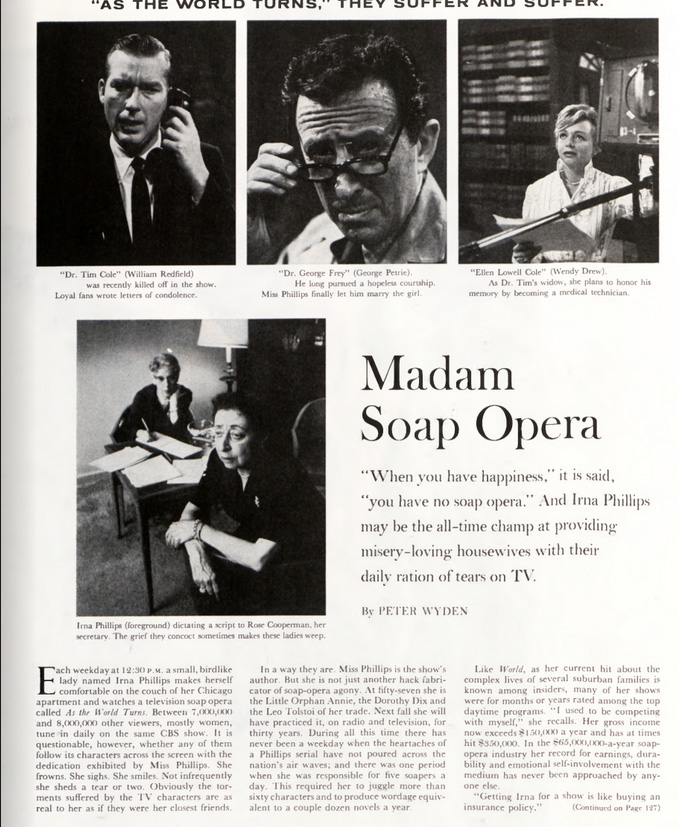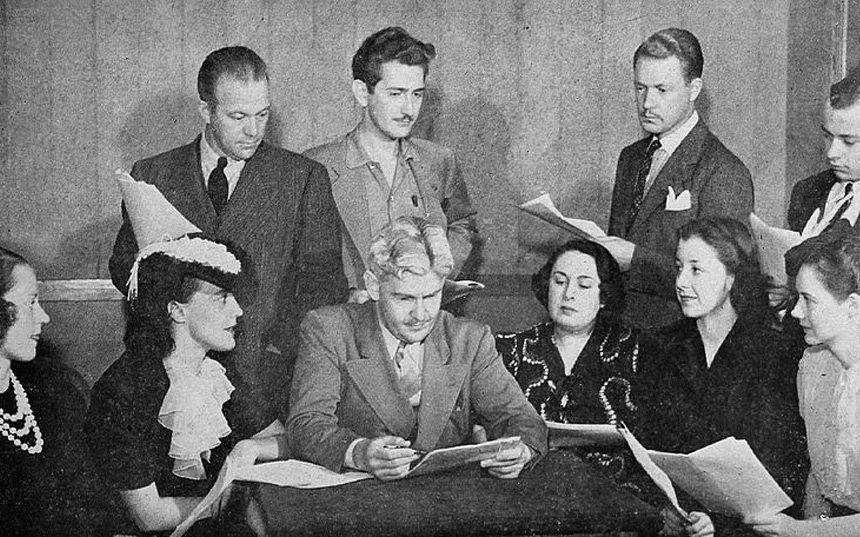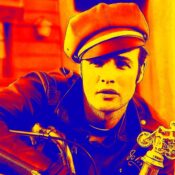Soap operas remain part of everyday American entertainment, but like anything in our culture, they had to start somewhere. These Are My Children, the first daytime soap, launched 70 years ago today, but the roots of the genre reach further back, first through primetime TV, and then into radio. One common thread unites all of those milestones, and her name was Irna Phillips, “The Queen of Soaps.”
The first daytime soap opera on the radio in the United States was called Painted Dreams; the 15-minute daily show debuted in October, 1930 on Chicago’s WGN. Irna Phillips, who was already a radio actress, created the show after a request from the station for a dramatic program centered on a family. The term “soap opera” began to get applied to this type of programming as the sponsors were frequently the creators of home and cleaning products, like Procter & Gamble, and the melodrama drew comparisons to operas, about which unhappy endings are an oft-invoked cliché.
Phillips pioneered a number of ideas that became part of the form. She came up with the notion of transition music between scenes (called the “organ bridge”) and ended episodes on a cliffhanger. A legal battle over ownership of the show drove Phillips to rival radio station WMAQ where she put together a clone of the program with renamed characters and rechristened the show Today’s Children. She then created a hospital-set radio show called Woman in White. During the production of that show, Phillips hired two people who would also be huge figures in the genre: Agnes Nixon and William J. Bell.
In 1937, Phillips created a new radio show, The Guiding Light. It would run on various networks until 1952, when it would make the switch to TV and run on CBS until 2009. But Phillips’s first television breakthrough was These Are My Children. First airing on January 31, 1949, the show aped the format of Painted Dreams and Today’s Children, following Irish widow Mrs. Henehan, her three children, and her daughter-in-law. It was only on the air a month, but by then, the dam had been broken.
After Guiding Light transitioned to success on TV, Phillips continued to creative shows with great staying power. In 1956, she created another CBS show, As the World Turns; by 1958, Turns became the highest-rated daytime drama, and would hold that distinction for more than 20 years. In 1964, Phillips and Bell co-created Another World for NBC; they would later turn the showrunner duties over to James Lipton (yes, he of Inside the Actor’s Studio), and he would later hand it off to another former Phillips apprentice, Agnes Nixon. Philips herself would be profiled by The Saturday Evening Post in 1960 in a piece you can read below.
The creative legacy of Phillips is unparalleled in the daytime genre. She created or co-created nearly two dozen programs for TV and radio. She consulted for other shows like Peyton Place and was a story editor for Days of Our Lives. Phillips also pioneered producer ownership of shows; after the lawsuit debacle involving Painted Dreams, she never again created a show that she didn’t at least partially own. Phillips’s independent streak extended to fighting for storylines; she quit her show Love is a Many Splendored Thing at CBS in the late ’60s after battling with the censors over storylines involving abortion and an interracial relationship between a white man and Amerasian woman. Her daughter, Kathleen, followed her mother into television, creating the show A World Apart in the ’70s (which featured one of the first roles for a young Susan Sarandon).
Phillips’s creative disciples stacked massive achievements atop her legacy. Bell became head writer on Days of Our Lives in 1966 and would go on to create (with his wife, Lee Phillip Bell) The Young & The Restless and The Bold & The Beautiful. The Bell children continue that family tradition today, with son Bradley serving as executive producer and head writer of Bold while daughter Lauralee remains a mainstay of the Restless cast in the role of Christine “Cricket” Blair. William Bell’s colleague Agnes Nixon forged her own path, creating One Life to Live, All My Children, and Loving (which later became The City).
Looking back now, it’s fair to say that the daytime soap opera genre rests firmly on the foundation put down by Irna Phillips. These Are My Children didn’t last long, but Phillips took the basic concepts, combined it with a fierce, independent spirit, and build a genre that has withstood the test of time. Whatever your personal opinion of daytime drama might be, it has entertained millions while being a durable staple of two broadcast mediums. One could speculate on how long the format can continue in the digital age, but we wouldn’t bet against something that’s always ready to continue tomorrow.
Feature Image: The radio cast of Guiding Light from 1940. Front row from left: Ruth Bailey (Rose Kransky), Gladys Heene (Torchy Reynolds), Dr. John Ruthledge, Mignon Schreiber (Mrs. Kransky), Muriel Bremner (Fredericka Lang), Betty Arnold (Iris Marsh), Back row from left: Bill Bouchey (Charles Cunningham), Paul Barnes (Jack Felzer), Phil Dakin (Ellis Smith), Seymour Young (Jacob Kransky). (Wikimedia Commons via Public Domain)

Become a Saturday Evening Post member and enjoy unlimited access. Subscribe now



